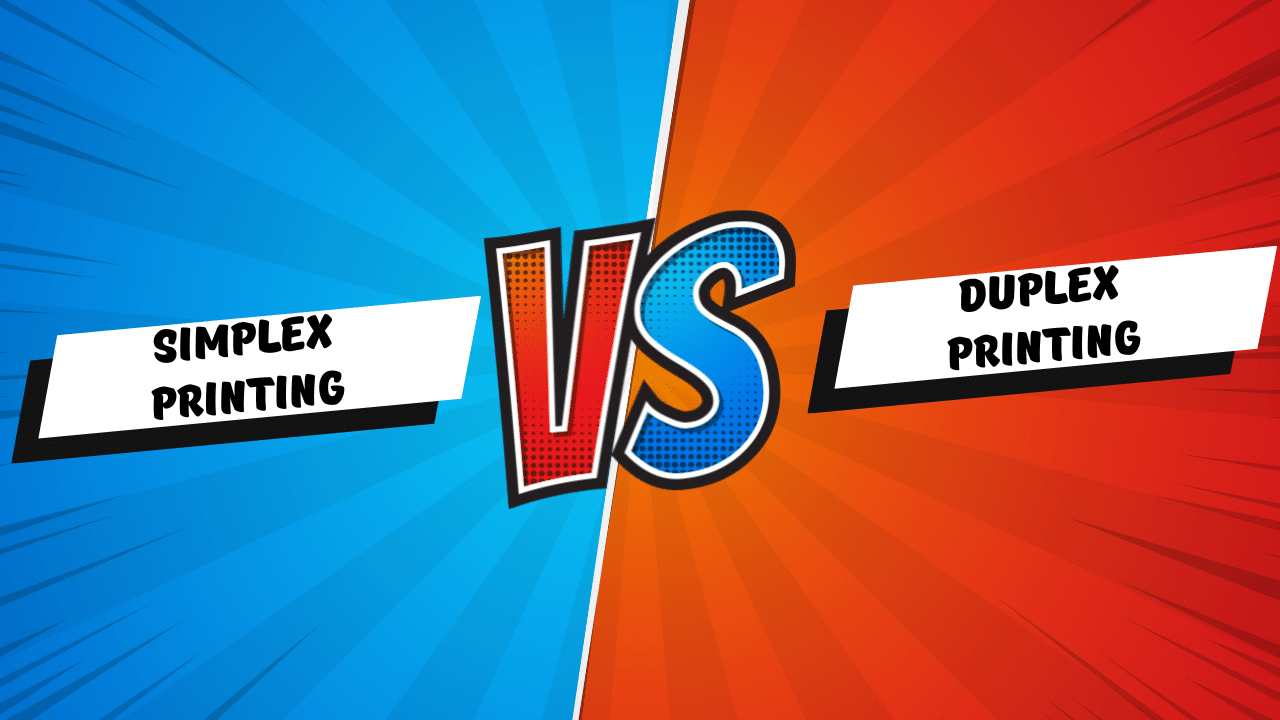Simplex vs Duplex Printing: A Comprehensive Guide Leave a comment
Table of Contents
Whether you’re managing print jobs at home, in the office, or for commercial purposes, one of the key considerations is whether to print in simplex (single-sided) or duplex (double-sided) mode. Understanding the difference between these two methods can help you make better decisions when it comes to printing efficiency, paper usage, and cost savings. In this comprehensive guide, we’ll explore what simplex and duplex printing mean, their benefits and drawbacks, and how to choose the right option for your printing needs.
What is Simplex Printing?
Simplex printing is the most basic type of printing, where the printer prints on only one side of the paper. This is the standard printing mode that most home and office printers default to, especially for documents that only require single-sided prints, such as forms, letters, or flyers.
Advantages of Simplex Printing:
- Faster Printing: Since the printer only prints on one side, it’s generally quicker. There is no need to pause for flipping the paper, resulting in faster completion times for large print jobs.
- No Paper Alignment Issues: With simplex printing, there’s no risk of alignment problems that can occur when trying to print on both sides.
- High-Quality Output: If you’re printing documents that require high quality, such as reports or proposals, printing on one side ensures no ink or toner bleeds through the paper, providing clearer results.
Disadvantages of Simplex Printing:
- Increased Paper Usage: Because simplex printing only uses one side of the paper, it consumes more sheets, which can increase costs over time.
- Bulkier Documents: Single-sided documents take up more space, both in terms of storage and physical weight, which can be inconvenient when managing large print jobs.
What is Duplex Printing?
Duplex printing refers to the process of printing on both sides of the paper. Some printers offer manual duplex printing, where you need to manually flip the paper, while others offer automatic duplex printing, where the printer automatically flips the paper for you.
Advantages of Duplex Printing:
- Paper Savings: Printing on both sides can reduce paper usage by up to 50%, which not only helps reduce costs but is also more eco-friendly.
- Compact Documents: Duplex printing reduces the size of printed materials, making them easier to bind, mail, or store.
- Professional Appearance: Double-sided prints are often preferred for professional materials like booklets, brochures, and reports. They offer a more polished and professional look.
Disadvantages of Duplex Printing:
- Slower Printing: Duplex printing usually takes more time than simplex because the printer needs to flip the paper over and realign it before printing on the reverse side.
- Alignment Issues: Depending on the printer, there may be slight misalignment between the front and back pages, which could be problematic for certain types of documents like presentations or formal reports.
Simplex vs Duplex: Cost Comparison
Simplex Printing Costs:
Simplex printing uses more paper, which can increase costs over time. This is especially true for businesses and schools, where hundreds or thousands of pages are printed every day. For example, printing 1,000 pages in simplex mode will require 1,000 sheets of paper.
Duplex Printing Costs:
Duplex printing can significantly cut paper costs by reducing the number of sheets used. For the same 1,000 pages, you would only need 500 sheets. However, printers with automatic duplex printing features tend to be more expensive upfront, so you’ll need to consider this initial investment.
When to Use Simplex Printing?
Simplex printing is ideal when:
- High-quality output is needed: For formal documents like legal papers, proposals, or presentations, printing on one side ensures no ink or toner bleeds through to the other side.
- Speed is a priority: Simplex printing is faster, so if you need to quickly print a batch of documents, it’s the better option.
- Shorter documents: For short documents or one-time prints, the extra paper used in simplex printing won’t significantly affect cost.
When to Use Duplex Printing?
Duplex printing is most suitable when:
- Large document volumes: If you print large reports or long documents frequently, duplex printing can save you a significant amount of paper and space.
- Cost and environmental impact matter: For businesses looking to cut paper costs or implement eco-friendly practices, duplex printing is the obvious choice.
- Professional materials: For creating booklets, brochures, or instructional manuals, duplex printing offers a sleek, compact, and professional look.
Automatic vs Manual Duplex Printing
There are two types of duplex printing:
Manual Duplex Printing:
With manual duplex printing, you need to manually flip the pages over once the first side has printed. This method is cheaper because it doesn’t require a printer with automatic duplex capabilities, but it can be time-consuming and prone to misalignment errors.
Automatic Duplex Printing:
Automatic duplex printing is a much more convenient option, especially for offices or people who regularly print double-sided documents. The printer automatically flips the paper for you, ensuring proper alignment and saving you time.
Conclusion: Choosing Between Simplex and Duplex Printing
Ultimately, whether you choose simplex or duplex printing depends on your printing needs, budget, and environmental goals. If you’re primarily printing high-quality, one-sided documents and need speed, simplex printing will serve you well. However, if you’re looking to save on paper costs, reduce environmental impact, and print professional double-sided materials, duplex printing is the way to go.
For most users, having a printer that can do both is ideal, giving you the flexibility to switch between simplex and duplex modes depending on the task at hand.

